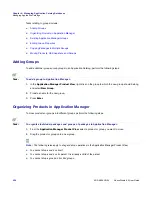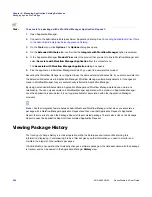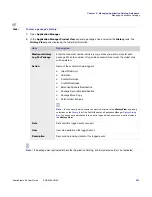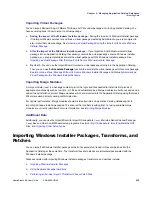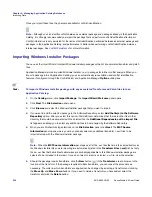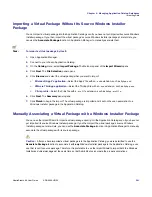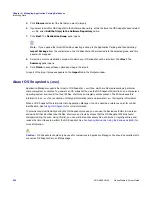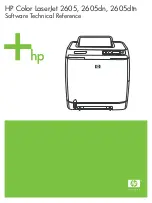
Chapter 6: Managing Application Catalog Databases
Importing Data
234
ADS-0950-UG00
AdminStudio 9.5 User Guide
•
ProductCode Property
—Unique identifier for the particular product release, represented as a string
GUID, for example:
{12345678-1234-1234-1234-123456789012}
•
Product Language
—The language the installer should use for any strings in the user interface that are
not authored into the database.
•
ProductVersion
—Version of the product in string format. The format of the string is: major.minor.build.
•
List of Transform Files
—A list of the transformations associated with this package.
•
[None Selected]
—If you do not select any of these five identifiers, Application Manager checks the
Product Name identifier to determine if a package is a duplicate.
4.
Click OK to save your changes and exit the
Options
dialog box
5.
Proceed with the package import, as described in
Importing Windows Installer Packages
.
Note •
If Application Manager is performing a bulk import or reimport, it still identifies duplicate packages using the
user-specified criterion. Application Manager will generate a unique displayed product name and allow the import to
proceed without prompting the user.
Note •
The options that you select on the
Duplicate Package
tab of the ConflictSolver and Application Manager
Options
dialog box apply globally to all packages that you attempt to import; you cannot apply different identifiers
to different packages. Also, since these options are saved in the AdminStudio Shared Directory, everyone using
AdminStudio at your organization will share the same Duplicate Package options.
Performing an Ad-Hoc Import of Transform Files or Patch Files
Edition •
You can only perform an ad-hoc import if you are connected to a Software Repository-enabled
Application Catalog. The Software Repository feature is included in AdminStudio Enterprise Edition.
In a large enterprise, transform and patch files are created frequently to modify packages for different situations in
their organization. For example, to localize a software application, a transform file is often created for each
language supported by that application. Systems Administrators in these large enterprises have to keep track of
which software package each file is supposed to be applied to.
You cannot tell which package a transform or patch file is associated with by just looking at the file. However, you
can use the Import Wizard to perform an
ad-hoc import
of these loose transform and patch files into your
Application Catalog. Then, Application Manager will:
•
Determine which of the packages in the Application Catalog the transform or patch file is associated with, and
•
Store the files in the Software Repository along with that package’s other associated files.
Summary of Contents for ADMINSTUDIO 9.5
Page 1: ...AdminStudio 9 5 User Guide Version 9 5...
Page 50: ...Contents 50 ADS 0950 UG00 AdminStudio 9 5 User Guide...
Page 52: ...52 ADS 0950 UG00 AdminStudio 9 5 User Guide...
Page 156: ...156 ADS 0950 UG00 AdminStudio 9 5 User Guide...
Page 440: ...440 ADS 0950 UG00 AdminStudio 9 5 User Guide...
Page 1090: ...1090 ADS 0950 UG00 AdminStudio 9 5 User Guide...
Page 1426: ...1426 ADS 0950 UG00 AdminStudio 9 5 User Guide...
Page 1686: ...1686 ADS 0950 UG00 AdminStudio 9 5 User Guide...
Page 1794: ...Chapter 24 AdminStudio Public API Reference 1794 ADS 0950 UG00 AdminStudio 9 5 User Guide...
Page 1842: ...Index 1842 ADS 0950 UG00 AdminStudio 9 5 User Guide...

